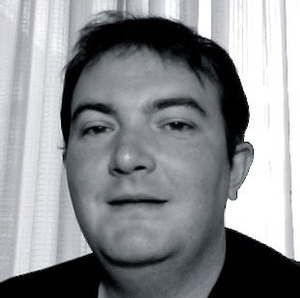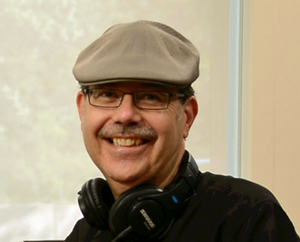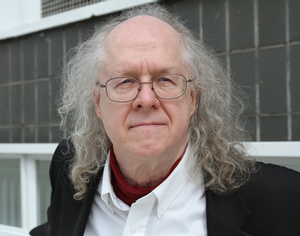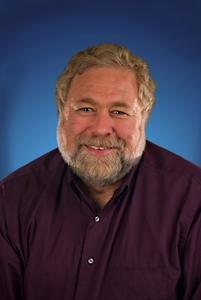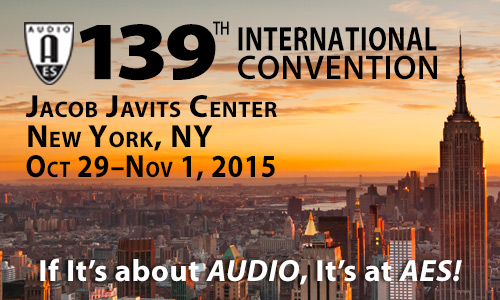
AES New York 2015
Networked Audio Track Event Details
Thursday, October 29, 2:15 pm — 3:15 pm (Room 1A14)
Networked Audio: N1 - Basic Networking and Layer 3 - Protocols: Layers, Models? A Disambiguation in the Context of Audio over IP
Presenter:Kieran Walsh, Audinate Pty. Ltd. - Ultimo, NSW, Australia
Abstract:
The OSI model is a great starting point to understand a structure for integrating network protocols and creating software. Topics for discussion include: • Examining the positives of a layered approach and fill in the “missing gaps” that are required to create a real implementation. • An implementation from a “solution provider” (manufacturer) is different to creating a real “on the ground” working full system – the Model and layered approach however can be valuable in converging these two challenges. • “Protocols, Standards, implementations” These terms are used interchangeably—they, however, have distinct meanings; we will examine the differences and distinctions of these terms. • Deploying core AoIP services in the context of other technologies that can be leveraged to make a fully working system function in an effective production environment. • Distinguishing between standards, implementations, transports, protocols, layers and have a better insight into what each means and how to define requirements for systems. • Understanding the IT centric approach to a network, and identify challenges and workarounds when deploying an AoIP system. • Understanding some techniques that “come for free” in an enterprise IT network environment
Thursday, October 29, 3:30 pm — 4:30 pm (Room 1A14)
Networked Audio: N2 - AVB/TSN Ethernet Is Built-In Everywhere Now; How Do You Make the Most of It? A System Implementation Primer for Consultants and Tech Managers
Chair:Tim Shuttleworth, Renkus Heinz - Oceanside, CA, USA
Panelists:
Richard Bugg, Meyer Sound - North HIlls, CA, USA
Jim Cooper, MOTU - Cambridge, MA, USA
Tom Knesel, Pivitec - Emmaus, PA, USA
Nathan Phillips, Coveloz Technologies - Ottawa, ON, Canada
Curtis Rex Reed, Harman - South Jordan, Utah
Abstract:
This presentation will introduce technology managers, integrators, and specifiers to the basics of distributing audio, video, and control signals over an Ethernet network in ready-to-play fashion. The presentation will also focus on system implementation with Time Sensitive Networking (TSN) standards—the evolution of Audio Video Bridging (AVB).
Attendees will be provided with a system-level understanding on how to achieve networked AV success; discuss the advantages of using a network; and overview challenges and approaches and provide tips and troubleshooting for networking with AVB/TSN. Discover how easy it is to scale and upgrade TSN systems.
An overview of the methods of time synchronization will also be outlined. AVnu Alliance will start by reviewing system requirements for demanding applications such as performance venue installs, house of worship, large convention systems, conference rooms and broadcast and discuss the Ethernet capabilities needed for the network including characteristics and definitions of TSN for these applications.
The presentation will highlight the importance of certification for interoperability. Finally, AVnu Alliance will present the existing tools and resources that designers need for successful TSN system operation.
Learning Objectives: • Gain a basic understanding of distributing audio, video and control systems over an Ethernet network and the advantages to doing so. • Understand the existing tools and resources that designers need to successfully operate TSN systems. • Understand what is required from a network for applications such as performance venue installs, houses of worship, conference rooms etc.
Friday, October 30, 9:00 am — 10:30 am (Room 1A10)
Broadcast and Streaming Media: B4 - Audio and IP: Are We There Yet?
Moderator:Steve Lampen, Belden - San Francisco, CA, USA
Panelists:
Kevin Gross, AVA Networks - Boulder, CO, USA
David Josephson, Josephson Engineering, Inc. - Santa Cruz, CA, USA
Dan Mortensen, Dansound Inc. - Seattle, WA, USA
Tony Peterle, Worldcast Systems - Miami, FL, USA
Tim Pozar, Fandor - San Francisco, CA, USA
Abstract:
In 2010, Reed Hundt, former head of the Federal Communications Commission, said in a speech at Columbia Business School, [We] “decided in 1994 that the Internet should be the common medium in the United States and broadcast should not be.” This was twenty-one years ago. So, are we there yet? I tried to invite Mr. Hundt to participate on this panel, but he is too well protected, I couldn’t even get an invitation to him.
This panel of esteemed experts will look at the “big picture” of audio in networked formats and internet delivery systems. Do we have the hardware and software we need? If not, what is missing? Can we expect the same quality, consistency, and reliability as we had in the old analog audio days? There are dozens, maybe hundreds, of companies using proprietary Layer 2/Layer 3 Ethernet for audio, and there is much work on combining or cross-fertilizing these systems, such as Dante and Ravenna. There are also new standards such as IEEE 802.1BA-2011 AVB (Audio-Video Bridging), and IEEE 802.1ASbt TSN (Time-Sensitive Networks) that use specialized Ethernet switches in a network architecture. But these do not address anything outside of the Ethernet network itself. Then we have AES IP67, specifically looking at “high performance” IP-based audio.
Mixed in with this is the question “What is a broadcaster? Do you have to have a transmitter to be a broadcaster?” Consider that next year (2016) one company claims they will be the largest broadcaster in the world, and that company is Netflix.
Friday, October 30, 10:30 am — 11:30 am (Room 1A14)
Networked Audio: N3 - AVB/TSN Implementation for Live Sound & House of Worship
Presenter:Tom Knesel, Pivitec - Emmaus, PA, USA
Abstract:
Ethernet AVB/TSN (Time Sensitive Networking) enables precise timing and synchronization and bandwidth reservation, making it an ideal solution for several of the consistency and convenience issues musicians’ face on the road and during live performances. International rock band, ACCEPT, has been touring the globe for over three decades, and for most of that time, they had to lug heavy performance equipment onto planes, trains and taxis or take the risk of using unfamiliar local equipment at each venue. They needed a solution that eliminated some gear and ensured a consistent sound and performance at each venue. That’s where a compact touring system, powered by Audio Video Bridging (AVB) stepped in.
For Houses of Worship, similar solutions can be implemented. NOW Church in Ocala, FL, has always incorporated cutting-edge technology into their facility, but they were looking for a system that would take them into the future. After hearing about the benefits of AVB they made the move to an AVID VENUE system for their Front of House, as well as the Pivitec personal monitoring system that they have described as a “game-changer.”
Tom Knesel, Co-Founder and President of Pivitec, will walk through the specifics of the AVB enabled systems for each install including lessons learned and how AVB was monumental in providing a powerful experience during ACCEPT’s and NOW Church’s performances. Knesel will present how AVB allowed these two installations to combat common sound issues on stage, create pre-sets, simplify travel, and most importantly, give them a future-proof way to take advantage of next-gen compatibility with hardware and software from other manufacturers.
Friday, October 30, 1:30 pm — 2:30 pm (Room 1A13)
Networked Audio: N4 - Namespace & Directory Services (i.e., ODA)
Presenter:Jeff Berryman, Bosch Communications - Ithaca, NY, USA
Abstract:
AES67 addresses interoperability in media transport over networks, AES X210 addresses command and control over networks (as does the ill fated AES64). Neither of these standards efforts tackles Namespace and Directory services, aspects such as Discovery and addressing. This session will explore requirements for these network services and looks forward to an AES standards effort for these services.
Friday, October 30, 2:30 pm — 4:00 pm (Room 1A13)
Networked Audio: N5 - Dante Case Studies
Presenters:John Huntington, NYC College of Technology - Brooklyn, NY, USA
Sam Kusnetz, Team Sound - Brooklyn, NY, USA
Joe Patten, Communications Design Associates - Canton, MA, USA
Abstract:
Part 1: Using an Audio Network for a Themed Attraction in an Academic Environment Sound Designer Sam Kusnetz and Network Engineer John Huntington give an overview of the Dante network that is the backbone of the audio system for the Gravesend Inn haunted attraction at Citytech in downtown Brooklyn. Here are two learning points: • The benefits of networked audio in themed attractions • Using networked audio over managed networks.
Part 2: Cost Saving and Digital Audio Networking The use of digitized audio networks has changed the flow of information and cost associated with it for the better. More channels of audio are available in more location with the installation cost greatly reduced. Benefits: • Savings with infrastructure such as cabling and conduit • Flexibility with routes or multiple routes/distribution of audio • Density of audio paths, 128 channels over single link via CAT6
Friday, October 30, 3:00 pm — 3:45 pm (Stage LSE)
Live Sound Expo: (Audio) Networking for Theater
Presenter:Marc Brunke, Optocore GmbH - Grafelfing, Germany
Abstract:
As with audio infrastructure in general, digital audio networking is permeating the theater. We examine why audio networking is finding a natural fit into theatrical applications, and discuss the details of network implementation.
AES Members can watch a video of this session for free.
Friday, October 30, 4:30 pm — 6:30 pm (Room 1A06)
Networked Audio: N6 - Network Performance Requirements for Audio Applications
Chair:Jim Meyer, Clair Global - Lititz, PA, USA
Panelists:
Gene Gerhiser, National Public Radio - Washington, DC, USA
Kevin Gross, AVA Networks - Boulder, CO, USA
Andreas Hildebrand, ALC NetworX GmbH - Munich, Germany
Greg Shay, The Telos Alliance - Cleveland, OH, USA
Dave Täht, Bufferbloat.net - Ft Myers, FL, USA; Karlstad University - Karlstadt, Sweden
Abstract:
Networks are now regularly used for many classes of audio applications. Some applications have higher performance requirements than others. For file-based workflow in post-production, for instance, the emphasis is on high throughput to minimize the time required to move files across the network between workstations and storage systems. For real-time applications—such as Dante, Q-LAN, and AES67—the emphasis is on latency and network stability. Older systems such as CobraNet, Ethersound, and AES50 have other specific requirements. When video and other network applications share the network with audio applications, network design considerations are potentially significantly more complex. This workshop will outline requirements for specific audio networking applications and technologies. The audience will learn about the design issues that must be considered to support these applications and technologies.
Friday, October 30, 7:00 pm — 9:00 pm (Off-Site 1)
Special Event: From the Ether: A Distributed Performance Concert and Panel Discussion
Moderator:Tom Beyer, New York University - New York, NY, USA
Presenters:
Michael Palumbo, York University - Toronto, Ontario
Tim Shuttleworth, Renkus Heinz - Oceanside, CA, USA
Abstract:
A special joint presentation by members of the AES Technical Committee on Network Audio Standards, in the Frederick Loewe Theater, at the Music and Performing Arts Professions Department’s Music Technology Program at New York University, and the Distributed Performance and Sensorial Immersion Lab at York University, Toronto. “From The Ether” is an international concert with performers located in New York, Toronto, Montreal, Stanford, CA; Tromsø, Norway; Buenos Aries, Argentina and Belfast, Ireland. Audio and video will be transmitted between all locations over high-bandwidth internet links. The AES audience in New York will hear the performers from all locations, and be treated to a multiple-screen projection of the concert: an audiovisual unification of spectators and performers. At each remote location, all global musicians’ contributions will be mixed locally together — each location will experience a complete orchestra.
In order to inform the audience as to how the underlying technology is being utilized, how they can use it, and how it serves the music, the producers have arranged for brief talks to precede the performances, each addressing a particular aspect of distributed performance, including: compositional considerations, equipment, techniques, and production affordances and constraints.
Location: Frederick Loewe Theater
35 W 4th St, New York, NY
Bus transportation is not provided. We'd suggest taking the 7 Train to the F, M, B, D, A, or C to W 4th St.
Limited to 300 people. A ticket is required - anyone showing up without a ticket will be turned away. You can obtain your ticket from the Tech Tours desk at the Javits during Registration Desk hours.
Saturday, October 31, 12:00 pm — 1:00 pm (Room 1A19)
TC Meeting: Network Audio Systems
Saturday, October 31, 1:30 pm — 2:30 pm (Room 1A13)
Networked Audio: N7 - Benefits of AES67 to the End User
Presenter:Rich Zwiebel, QSC - Boulder, CO, USA; K2
Abstract:
Presenter Rich Zwiebel has a long history in audio networking. He was a founder of Peak Audio, the company that developed CobraNet, the first widely used audio network for Professional applications. As a VP at QSC he continues to be very active in the field and is currently the Chairman of the Media Networking Alliance.
This presentation reviews the history of professional audio networking, where we are today, and what the future may hold. A clear explanation of what AES67 is, as well as what it is not, along with how it will benefit those who choose to use it will be included. Attendees will understand it’s relationship to existing audio network technologies in the market.
Additionally, an explanation of who the Media Networking
Alliance is, who it’s members are, and what it’s goals are will be presented.
A discussion of the advantages of a single facility network will close out the session.
Saturday, October 31, 3:15 pm — 4:45 pm (Room 1A14)
Networked Audio: N8 - How to Get AES67 into Your Systems/Products
Chair:Andreas Hildebrand, ALC NetworX GmbH - Munich, Germany
Panelists:
Michael Dosch, Lawo AG - Rastatt Germany
Nathan Phillips, Coveloz Technologies - Ottawa, ON, Canada
Greg Shay, The Telos Alliance - Cleveland, OH, USA
Nicolas Sturmel, Digigram S.A. - Montbonnot, France
Arie van den Broek, Archwave Technologies - Schwerzenbach, Switzerland
Kieran Walsh, Audinate Pty. Ltd. - Ultimo, NSW, Australia
Abstract:
This workshop introduces several options to implement AES67 networking capabilities into existing or newly designed products. The session starts with a quick recap on the technical ingredients of AES67 and points out the principal options on implementing AES67 into new or existing products. After providing an overview on commercially available building blocks (modules, software libraries and reference designs), the workshop commences in a discussion on the value of providing AES67 compatibility from the perspective of providers of existing AoIP networking solutions. The workshop is targeted towards product manufacturers seeking ways to implement AES67 into their products, but should also provide valuable insight to those with general technical interest in AES67.
Saturday, October 31, 5:00 pm — 6:30 pm (Room 1A14)
Networked Audio: N9 - How Will AES67 Affect the Industry?
Chair:Rich Zwiebel, QSC - Boulder, CO, USA; K2
Panelists:
Claude Cellier, Merging Technologies - Puidoux, Switzerland
Andreas Hildebrand, ALC NetworX GmbH - Munich, Germany
Patrick Killianey, Yamaha Professional Audio - Buena Park, CA, USA
Phil Wagner, Focusrite Novation Inc. - El Segundo, CA
Ethan Wetzell, Bosch Communications Systems - Burnsville, MN USA; OCA Alliance
Abstract:
There are many audio networking standards available today. Unfortunately, equipment designers and facility engineers have been forced to choose between them to adopt a single platform for an entire operation, or link disparate network pools by traditional cabling (analog, AES/EBU or MADI). AES67 solves this dilemma, providing a common interchange format for various network platforms to exchange audio without sacrificing proprietary advantages. Published in 2013, manufacturers are already showing products with AES67 connectivity this year. Join our panel of six industry experts for an open discussion on how AES67 will impact our industry.
Sunday, November 1, 11:00 am — 12:30 pm (Room 1A12)
Networked Audio: N10 - AES67 Interoperability Testing
Chair:Kevin Gross, AVA Networks - Boulder, CO, USA
Panelists:
Andreas Hildebrand, ALC NetworX GmbH - Munich, Germany
Peter Stevens, BBC Research & Development - London, UK
Nicolas Sturmel, Digigram S.A. - Montbonnot, France
Abstract:
The AES has now planned two plugfests for AES67 implementers and users. The first plugfest was held in October 2014 at IRT in Munich. A report describing this event was produced and published by the AESSC as AES-R12-2014. The second plugfest is planned for early November in Washington D.C. at NPR headquarters. This workshop will summarize the testing performed and will present results. A panel comprising plugfest participants will answer audience questions and the audience should get a good feel for where AES67 implementation stands.
